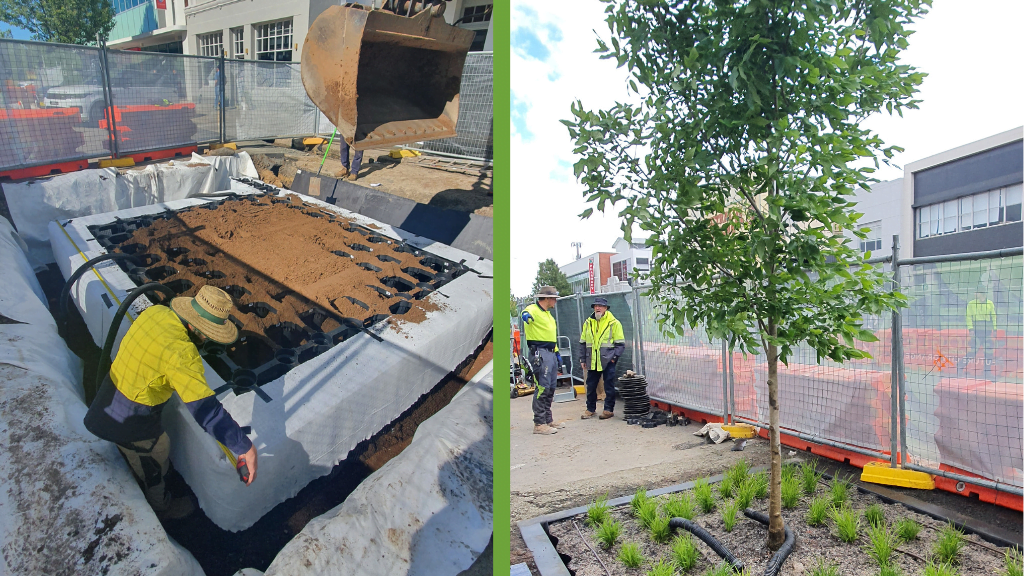Posted by Kristyn Maslog-Levis on Thu, Dec 26, 2013 @ 12:06 AM
Do Soil Cells Improve Soil Quality for Green Urban Infrastructure?
Based on a report by Richard J. Magill, Magill & Associates, Inc. & Simon Leake, Principal/Director of Operations SESL Australia

Are Structural Soil Vaults and Quality Soil a Mix made in Heaven?
As all green building professionals know, healthy trees play a significant role in successful green infrastructure systems in urban environments.
Unfortunately, too many urban projects worldwide have inadequate tree planting practices that results in failed or diminished results. These commonly accepted practices often lack the proper improvement of inherently poor soil, and fail to adequately address the impaired surrounding substratum, as these are the site conditions typically encountered in urban landscaping projects.
Trees need significant volumes of low-compaction soils, with suitable pore space, drainage, and organic matter to provide for long-term growth. Because individual project and site conditions vary so dramatically, it is often necessary to adjust the soil ingredient mixture accordingly to the location and the trees specified. Simon Leake, principal of Sidney Environmental Soils Laboratories (SESL) in Australia, favors a “Logical Approach to Soil Specification”.
This approach promotes the idea that performance-based specifications are more effective than “recipe-based” soil specifications. Leake’s laboratory’s “fit for purpose” soils will optimize the water, nutrient and aeration properties to be consistent with the intended use.
Another important aspect is the condition of the underground areas (substratum) surrounding the immediate tree pit location. Plants require a certain amount of lateral space underground for optimum root volume. Also necessary in urban streetscape is structural integrity and support for surrounding infrastructure.
The need for adequate space and soil for healthy root growth and the need for various hardscaped areas, such as sidewalks, streets, and malls, are typically at odds because paved areas demand a certain compaction below them to function properly and compacted soil severely restricts root growth.
There have been a number of projects that have utilized the “suspended pavement” approach by constructing concrete “post and beam” structures in excavated areas and backfilling with quality soil, thus providing for structural support and adequate root growth. Unfortunately, these projects have proven to be cumbersome and quite costly.
To address these issues, Cornell University developed Structural Soils in the mid-1990s. Structural soil is a mixture of stone aggregate and soil, with a small amount of polymer gel to hold the mix together. However, structural soils have limited success for good tree growth because of the lack of actual soil content in the structural mix. With only about 20% soil and 80% structural components such as larger rocks and gap-graded gravels, and highly compacted soil levels to support the above-ground infrastructure, the trees struggle to grow to the intended maturity due to stunted tree root growth and the limited availability of nutrients from the soil.
This is where Citygreen’s® Stratavault™ system comes in. These modular, pre-engineered structural soil vaults are designed to accommodate irregular urban conditions and provide 95% of the space within the vaults for tree-rooting soil. The structural soil vault provides for a “tree pit vault system” that allows for improved underground spaces for quality soils, optimum tree root volume, and superior structural support for urban hardscapes.

Structural soil vaults(soil cells) are constructed of recycled thermoplastic material that is relatively lightweight, extremely durable, and non-toxic. The use of these materials reduces environmental impacts because they simply require less embodied energy to produce, transport and install. Recycled plastic soil vaults are also more cost-effective than other systems due to lower production and shipping costs. Citygreen’s Stratavault modules are made of 100% recycled plastics.
Aside from that, they also serve an important function in stormwater management because they allow water to move more freely through the root zones, and ultimately into the aquifer, as opposed to running on the surface and into overburdened urban stormwater management systems. These matrix vault systems are proving to be much more efficient and cost-effective than previous approaches.
Unfortunately these days there are still building professionals that plant trees improperly due to design constraints, budgetary issues, and substandard installation practices. The key to changing this is the improvement of local building codes and standard operating procedures to ensure trees in urban settings are planted in environments that will ensure they live for their intended lifespan. Also, increased diligence by all of the key decision-makers in the approval, design, and installation of urban infrastructure will promote the use of quality soils and innovative support structures, such as the Structural soil vault Stratavault system, to insure the future long-term success of urban forests.
Upcoming Project? Book a Consult with a Citygreen Consultant

